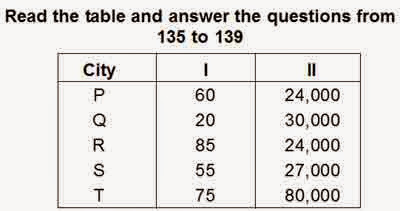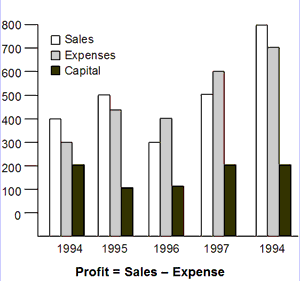Practice Papers for SSC Exams - "Arithmetic"
Practice Papers for SSC Exams "Arithmetic"
Q1. A man buys 12 articles for Rs. 12/- and sells them at the rate of Rs. 1.25 per article. His gain percentage is
(a) 20
(b) 25
(c) 15
(d) 18
Q2. The cost price of 15 articles is same as the selling price of 10 articles. The profit per cent is:
(a) 30%
(b) 40%
(c) 50%
(d) 45%
Q3. By selling an article for Rs. 240, a man incurrs a loss of 10%. At what price should he sell it, so that he makes a profit of 20% ?
(a) Rs. 264
(b) Rs. 288
(c) Rs. 300
(d) Rs. 320
Q4. A house and a shop were sold for Rs. 1 lakh each. In this transaction, the house sale resulted into 20% loss whereas the shop sale into 20% profit. The entire transaction resulted in
(a) no loss no gain
(b) gain of Rs. lakh
(c) loss of Rs. lakh
(d) loss of Rs. lakh
Q5. If a man estimates his loss as 20% of the selling price,
then his loss per cent is
(a) 20%
(b) 25%
(c) 40/3%
(d) Data inadequate
Q6. If x = and Y = ,then x : y : z, is equal to
(a) 3: 2: 1
(b) 1: 2: 6
(c) 1: 3: 6
(d) 2: 4: 6
Q7. Divide Rs. 1250 among A, B, C, so that A gets of B’s share and C gets 4 of A’s share.
(a) Rs. 200, Rs. 800, Rs. 250
(b) Rs. 200, Rs. 900, Rs. 150
(c) Rs. 150, Rs. 800, Rs. 300
(d) Rs. 200, Rs. 900, Rs. 75
Q8. The ratio of two numbers is 3 :8 and their difference is 115. The smaller of the two numbers is
(a) 184
(b) 194
(c) 69
(d) 59
Q9. Between two consecutive years my incomes are in the ratio of 2 : 3 and
expenses in the ratio 5 : 9. If my income in the second year is Rs. 45000 and my
expenses in the first year is Rs. 25000 my total savings for the two years is
(a) Nil
(b) Rs. 15000
(c) Rs. 10000
(d) Rs. 5000
Q10. Rs. 180 contained in a box consists of one rupee, 50 paise and 25 paise coins in the ratio 2 : 3 : 4. What is the number of 50 paise coins?
(a) 60
(b) 120
(c) 150
(d) 180
Q11. Of the three numbers whose average is 60, the first is one fourth of the sum of the others. The first number is
(a) 30
(b) 36
(c) 42
(d) 45
Q12. The average of 11 numbers is 10.8. If the average of the first six be 10.4 and that of the last six is 11.5, then the middle (6th) number is
(a) 10.3
(b) 12.6
(c) 13.5
(d) 15.5
Q13. The average age of 12 players of a team is 25 years. If the captain’s age
is included, the average age increases by 1 year. The age of the captain is :
(a) 25 yrs.
(b) 38 yrs.
(c) 36 yrs.
(d) 26 yrs.
Q14. The average income of 40 persons is Rs. 4200 and that of another 35 persons is Rs. 4000. The average income of the whole group is:
(a) Rs. 4100
(b) Rs. 4106 3
(c) Rs. 410623
(d) Rs. 4108 3
Q15. The length of the diagonal of a square is ‘a’ cm. Which of the following
represents the area of the square (in sq. cm.) ?
(a) 2a
![]()
(c) a2/2
(d) a2/4
Q16. If the volumes of two cubes are in the ratio 27: 1, the ratio of their edges is
(a) 3 : 1
(b) 27 : 1
(c) 1 :3
(d) 1 : 27
Q17. The sides of a rectangular plot are in the ratio 5:4 and its area is equal to 500 sq.m. The perimeter of the plot is
(a) 80m.
(b) 100m.
(c) 90m.
(d) 95m.
Q18. The radius of a wheel is 21 cm. How many revolution will it make in travelling 924 metres?
(a) 7
(b) 11
(c) 200
(d) 700
Q19. The edges of a cuboid are in the ratio 1 : 2 : 3 and its surface area is 88cm2. The volume of the cuboid is:
(a) 120 cm3
(b) 64 cm3
(c) ,48 cm3
(d) 24 cm3
Q20. The area of a sector of a circle of radius 5 cm, formed by an arc of length 3.5 cm is
(a) 8.5 cm2
(b) 8.75 cm2
(c) 7.75 cm2
(d) 7.50 cm2
Q21.

Q22. A solid metallic cone of height 10 cm, radius of base 20 cm is melted to
make spherical balls each of 4 cm. diameter. How many such balls can be made ?
(a) 25
(b) 75
(c) 50
(d) 125
Q23. The height of a conical tank is 60 cm and the diameter of its base is 64cm. The cost of painting it from outside at the rate of Rs. 35 per sq. m. is
(a) Rs. 52.00 approx.
(b) Rs. 39.20 approx.
(c) Rs. 35.20 approx.
(d) Rs. 23.94 approx
Q24. A cylindrical tank of diameter 35 cm is full of water. If 11 litres of water is drawn off, the water level in the tank will drop by :

Q25. A and B can do a piece of work in 72 days. B and C can do it in 120 days, A
and C can do it in 90 days. In how many days all the three together can do the
work ?
(a) 80 days
(b) 100 days
(c) 60 days
(d) 150 days
Q26. Suman can do a work in 3 days. Sumati can do the same work in 2 days. Both of them finish the work together and get Rs. 150. What is the share of Suman ?
(a) Rs. 30
(b) Rs. 60
(c) Rs. 70
(d) Rs. 75
Q27. Three taps A, B and C can fill a tank in 12, 15 and 20 hours respectively. If A, is open all the time and B and C are open for one hour each alternatively, the tank will be full in
(a) 6 hours
(b) 6 hours 40 min
(c) 7 hours
(d) 7 hours 30 min
Q28. 5 men can do a piece of work in 6 days while 10 women can do it in 5 days. In how many days can 5 women and 3 men do it ?
(a) 4
(b) 5
(c) 6
(d) 8
Q29. A can do a piece of work in 12 days and B can do it in 18 days. They work together for 2 days and then A leaves. How long will B take to finish the remaining work ?
(a) 6 days
(b) 8 days
(c) 10 days
(d) 13 days
Q30. A train is travelling at the rate of 45krn/hr. How many seconds, it will take to cover a distance of km ?
(a) 36
(b) 64
(c) 90
(d) 120
Q31. A person travels 600 km by train at 80km/hr, 800 km by ship at 40 km/hr. 500 km by aeroplane at 400 km/hr and 100 km by car at 50km/hr. What is the average speed for the entire distance ?

Q32. A train 100m long is running at the speed of 30 km/ hr. The time (in
second) in which it will pass a man standing near the railway line is
(a) 10
(b) 11
(c) 12
(d) 15
Q33bridge of 1200 metres long. If they walk towards each other at the rate of 5m/minute and 10m/minute respectively, in how much time will they meet each other ?
(a) 60 minutes
(b) 80 minutes
(c) 85 minutes
(d) 90 minutes
Q34. An aeroplane covers a certain distance at a speed of 240 km. per hour in 5 hours. To cover the same distance in hours, it must travel at a speed of
(a) 300 km./hr.
(b) 360 km./hr.
(c) 600 km./hr.
(d) 720 km./hr.
Directions: A survery of film watching habits of people living in five cities P,
Q, R, S and T is summarised below in a table. The coulmn I in the table gives
percentage of film-watchers in each city who see only one film a week. The
column II gives the total number of film-watchers who see two or more films per
week.
Read the table and answer the questions from 135 to 139

Q35. How many film watchers in city R see only one film in a week ?
(a) 24850
(b) 36000
(c) 136000
(d) 160000
Q36. Which city has the highest number of film watchers who see only one film in a week?
(a) P
(b) R
(c) S
(d) T
Q37. A city with the lowest number of film-watchers is
(a) P
(b) Q
(c) R
(d) S
Q38. The highest number of filmwatchers in any given city is
(a) Q
(b) R
(c) S
(d) T
Q39. The total number of all filmwatchers in the five cities who see only one film in a week is
(a) 113000
(b) 425200
(c) 452500
(d) 500000
Directions: The following graph gives Sales, Expense and Capital of a company for a period of five years 1994 to 1998. .Read the graph and answer the questions 40 to 44.

Q40. What has been the simple average growth rate per annum of expense between 1994 and 1998?
(a) 25%
(b) 33 3
(c) 40%
(d) 130%
Q41. In which year was the Sales to Expense ratio the lowest?
(a) 1994
(b) 1996
(c) 1997
(d) 1998
Q42. What was the average per annum increase in sales (in Rs. cr.) from 1994 to 1998 ?
(a) 50
(b) 60
(c) 80
(d) 100
Q43. In which year was the ratio of profits to capital the highest?
(a) 1998
(b) 1995
(c) 1996
(d) 1997
Q44. In which year was the ratio of sales to capital the lowest ?
(a) 1998
(b) 1997
(c) 1996
(d) 1995
Q45. Find x in the adjoining figure

(a) 1.6 cm
(b) 2.2 cm
(c) 3 cm
(d) 2.6 cm
Q46. In the given figure, AB, CD, EF are concurrent straight lines which pass
through O. If Ð AOE = 90° and x : y = 21, find ÐDOB and
Ð COF.General english.
(a) 50°, 100°
(b) 30°, 60°
(c) 45°, 90°
(d) 25°, 50°
Q47. Find the intercepts made by the line 2x – 3y + 6 = 0 with the coordinate axes.
(a) 3, 2
(b) –3, 2
(c) –3, –2
(d) None of these
Q48. The equation of the line whose intercept on the axes are 4 and 3 is
(a) 3x – 4y =10
(b) 3x + 4y =12
(c) –3x + 4y = 5
(d) None of these
Q49. Which of the following expression is a monomial?
(a) x
(b) –y2
(c) 2x3
(d) All the three
Q50.



